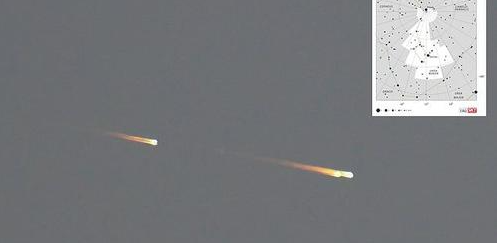The Ursid Meteor Shower will peak tonight with around five shooting stars every hour, according to astronomers.
The Ursid shower takes place every year between December 17 and 23, but this year it peaks in the pre-dawn hours of Wednesday, December 22.
Also known as the Ursids, the display is caused by a stream of debris left behind by 8P/Tuttle – a comet about the size of Manhattan – smashing into Earth’s atmosphere.
Ursids can be seen with the naked eye so there’s no need for binoculars or a telescope, though stargazers will need to wrap up warm tonight and allow their eyes to adjust to the dark.
Ursids marks the final meteor shower of the year. They also follow the start of winter solstice – the shortest day of the year – on Tuesday.
However, the display is usually sparse, producing around five meteors per hour at its peak, or 10 in ideal conditions with little light pollution.
‘The Ursids meteor shower is a fairly minor display occurring in late December,’ Dr Greg Brown, astronomer at the Royal Observatory Greenwich, told PA Media.
‘With at best around 10 meteors per hour in ideal conditions, many observers won’t see more than a few meteors even around the peak.
‘However, if you want to try and see this shower for yourself the usual tips apply.
‘Try and find a place with a low horizon to grant yourself the best view of the sky, and wait for the early hours of the morning when the shower will be at its best.
‘Fill your view with as much of the sky as possible (a deckchair can be a real help here) and wait.’
According to Earth Sky, the Ursids are best seen from the Northern Hemisphere.
‘From the Southern Hemisphere, you might see a few Ursids come streaking up from your northern horizon around the time the shower peaks. Or you might see no meteors at all,’ it says.
Meteors, also known as shooting stars, come from leftover comet particles and bits from broken asteroids.
When comets come around the Sun, the dust they emit gradually spreads into a dusty trail around their orbits.
Every year the Earth passes through these debris trails, which allows the bits to collide with our atmosphere where they disintegrate to create fiery and colourful streaks in the sky.
However, the events won’t pose a threat to humans as the objects nearly always burn up in our atmosphere before reaching the planet’s surface.
This particular meteor shower is called the Ursids because the meteors seem to come from near the Beta Ursae Minoris (Kochab) in the constellation Ursa Minor.
But the actual source of the shooting stars is a stream of debris left behind by comet 8P/Tuttle, which is comparable in size to the island of Manhattan and orbits the Sun every 4,970 days (13.61 years).
Luckily, the Moon will be in its first quarter phase during the shower’s peak in the early hours of Wednesday, so views of Ursids won’t be ruined by moonlight.
Also, with the shower occurring around the time of the winter solstice, people will have maximum hours of darkness to try to spot the stream of debris.
For the Northern Hemisphere, the winter solstice occurs annually on December 21 or 22.
This year it comes on December 21, officially marking the longest day of the year and the start of winter.
Solstices occur when the planet’s geographical pole in the Northern or Southern Hemisphere is most greatly inclined towards the Sun.
Along with the two equinoxes, the two solstices of the year mark the changing of seasons as Earth travels around the Sun.
After the winter solstice, the Northern Hemisphere starts seeing more hours of daylight each day.
Technically, today marks the start of ‘astronomical winter’, which is one of two definitions of when the seasons start and end.
Astronomical winter is different from meteorological winter, which always commences on December 1 and ends February 28 or 29 if there’s a leap year.
Meteorological seasons are based on the annual temperature cycle and are more rigidly defined by the months of the year.
The Met Office explains: ‘These seasons are split to coincide with our Gregorian calendar, making it easier for meteorological observing and forecasting to compare seasonal and monthly statistics.’



